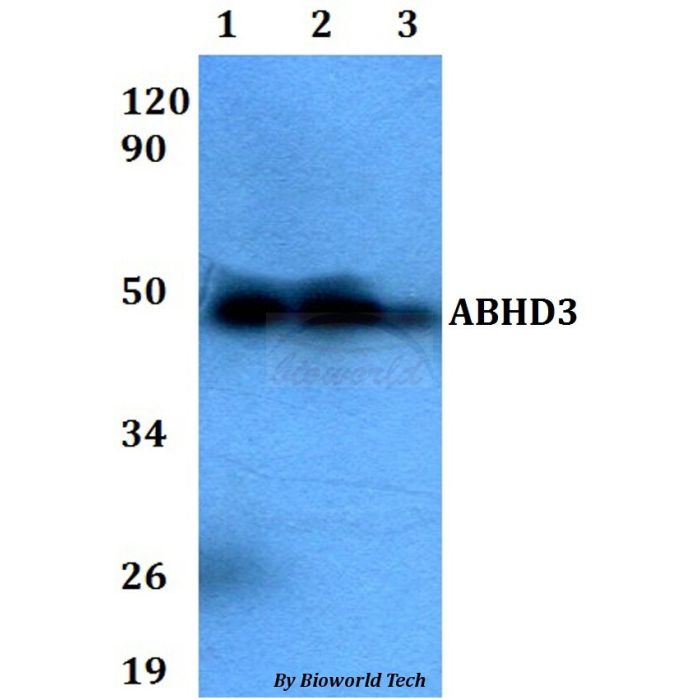ABHD3 polyclonal, anti-human, mouse, rat
€305.00
In stock
SKU
BS60632
Background:
The α/β hydrolase superfamily comprise diverse members that are involved in important biochemical processes and related to various diseases. They have unrelated sequences, various substrates, and different kinds of catalytic activities, yet they share the same canonical α/β hydrolase fold, which consists of an eight stranded parallel α/β structure. They are also characterized by a catalytic triad composed of a histidine, an acid and a nucleophile. Members of this superfamily are often drug targets for treating diseases, such as diabetes, Alzheimer’s disease, obesity and blood clotting disorders. The α/β hydrolase domain containing (ABHD) gene subfamily is comprised of 15 mostly uncharacterized members, most of which utilize a serine nucleophile to form the G-X-S-X-G nucleophile elbow. ABHD1 plays a role in metabolizing smoking xenobiotics. ABHD2 participates in the development of atherosclerosis. ABHD3 is a 409 amino acid single-pass type II membrane protein. ABHD4 is involved in an alternative synthesis pathway of NAE (N-acyl ethanolamine). Mutations in ABHD5 contribute to Chanarin-Dorfman syndrome. ABDH6 may play a role in nervous system metabolism and signaling.
Alternative Name:
Abhydrolase domain-containing protein 3, Lung alpha/beta hydrolase 3, ABHD3, LABH3
Application Dilution: WB: 1:500~1:1000, IHC: 1:50~1:200
Specificity: ABHD3 polyclonal antibody detects endogenous levels of ABHD3 protein.
Immunogen:
A synthetic peptide corresponding to residues in Human ABHD3
MW: ~ 46 kDa
Swis Prot.: Q8WU67
Purification & Purity:
The antibody was affinity-purified from rabbit antiserum by affinity-chromatography using epitope-specific immunogen and the purity is > 95% (by SDS-PAGE).
Format:
1 mg/ml in Phosphate buffered saline (PBS) with 15 mM sodium azide, approx. pH 7.2.
Storage:
Store at 4°C short term. Aliquot and store at -20°C long term. Avoid freeze-thaw cycles.
For research use only, not for use in diagnostic procedure.
The α/β hydrolase superfamily comprise diverse members that are involved in important biochemical processes and related to various diseases. They have unrelated sequences, various substrates, and different kinds of catalytic activities, yet they share the same canonical α/β hydrolase fold, which consists of an eight stranded parallel α/β structure. They are also characterized by a catalytic triad composed of a histidine, an acid and a nucleophile. Members of this superfamily are often drug targets for treating diseases, such as diabetes, Alzheimer’s disease, obesity and blood clotting disorders. The α/β hydrolase domain containing (ABHD) gene subfamily is comprised of 15 mostly uncharacterized members, most of which utilize a serine nucleophile to form the G-X-S-X-G nucleophile elbow. ABHD1 plays a role in metabolizing smoking xenobiotics. ABHD2 participates in the development of atherosclerosis. ABHD3 is a 409 amino acid single-pass type II membrane protein. ABHD4 is involved in an alternative synthesis pathway of NAE (N-acyl ethanolamine). Mutations in ABHD5 contribute to Chanarin-Dorfman syndrome. ABDH6 may play a role in nervous system metabolism and signaling.
Alternative Name:
Abhydrolase domain-containing protein 3, Lung alpha/beta hydrolase 3, ABHD3, LABH3
Application Dilution: WB: 1:500~1:1000, IHC: 1:50~1:200
Specificity: ABHD3 polyclonal antibody detects endogenous levels of ABHD3 protein.
Immunogen:
A synthetic peptide corresponding to residues in Human ABHD3
MW: ~ 46 kDa
Swis Prot.: Q8WU67
Purification & Purity:
The antibody was affinity-purified from rabbit antiserum by affinity-chromatography using epitope-specific immunogen and the purity is > 95% (by SDS-PAGE).
Format:
1 mg/ml in Phosphate buffered saline (PBS) with 15 mM sodium azide, approx. pH 7.2.
Storage:
Store at 4°C short term. Aliquot and store at -20°C long term. Avoid freeze-thaw cycles.
For research use only, not for use in diagnostic procedure.
| Is Featured? | No |
|---|
Write Your Own Review

